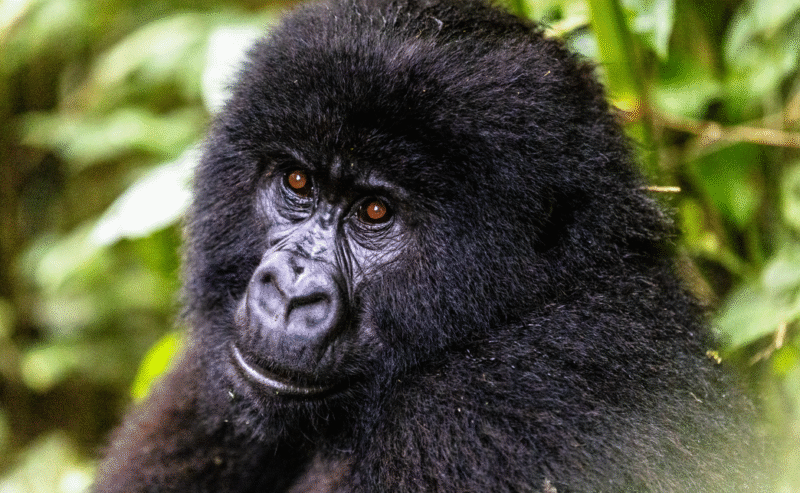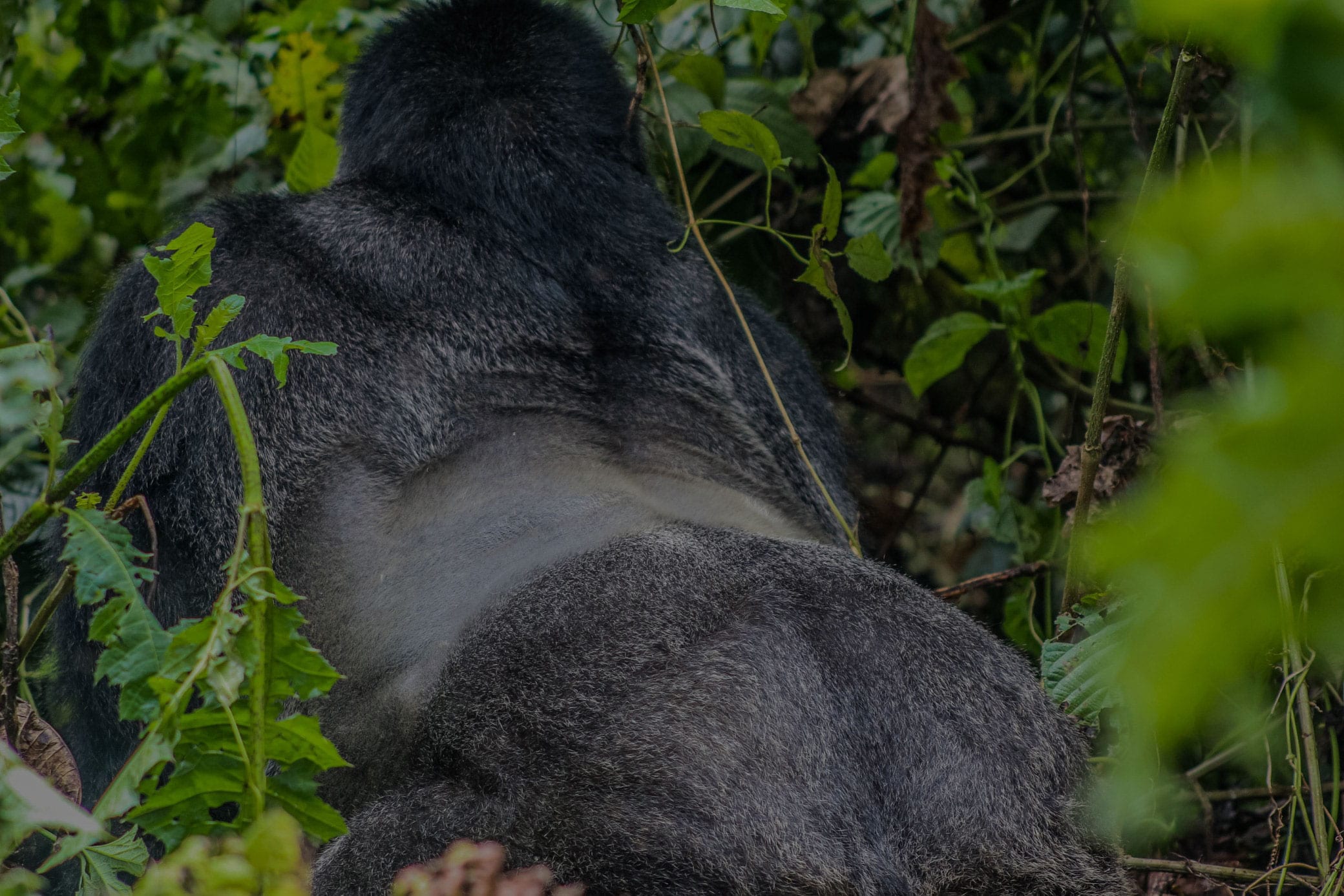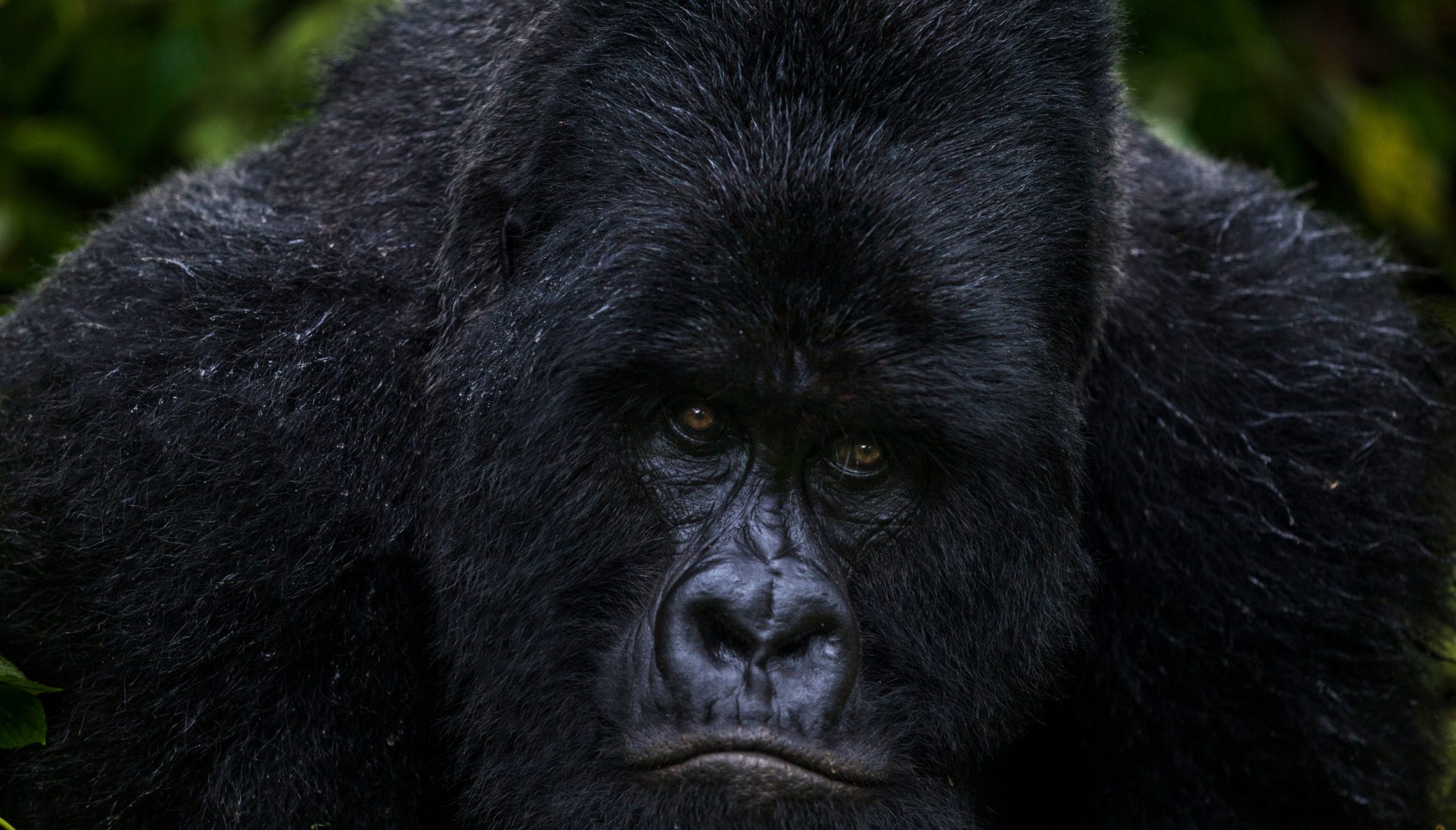
Support Virunga this Giving Season >

A silverback mountain gorilla is an adult male identifiable by the swathe of silver hair on its back. As well as this impressive signifier of maturity, they are famed for displays of aggression and dominance including whooping, charging, chest beating, tree slapping, and less commonly, physical duels.
A typical silverback weighs 430 pounds (195 kg) and stands 5 feet (1.5m) tall. Silverbacks are incredibly strong and can lift over 1763 pounds (800kg) of dead weight. That’s roughly twice as much as a well trained weightlifter. In the wild, a silverback uses its immense strength to fell trees in order to reach their fruits. This makes mountain gorillas a keystone species in Virunga, since they significantly affect the ecology of their environment.
A dominant silverback is responsible for directing troop activities such as nesting, feeding and migration between seasonal feeding areas. While vying to retain and recruit females during clashes with other troops, a dominant silverback will defend members of his troop to the death.
Despite a dominant silverback retaining mating rights over all females within his troop, higher ranking silverbacks in multi-male groups are often able to mate with a small proportion of females.
A male gorilla matures into a silverback at around fourteen years old. Although there can be multiple silverbacks within a troop, there is always one male that dominates over all other gorillas (except in rare instances of matriarch-led troops). In Virunga National Park, habituated families are normally named after the silverback leading the troop at the beginning of the habituation process – a method of conservation by which gorilla families become accustomed to close contact with humans.
Nevertheless, a dominant silverback will rarely choose sides in an all female dispute, for his ultimate goal is to foster conditions favourable to reproductive success.
Mature females regularly migrate between families to improve reproductive chances and avoid inbreeding. No matter the family a female belongs to, she will strive to have close contact and a strong bond with the dominant silverback. This helps prevent harassment from other males and reduces the threat of hostility from non-related females encountered through migration.
Internal conflicts between silverbacks normally constitute displays of aggression rather than physical contact. However fights do occur, sometimes to the death.
Coalitions may lead to subordinate males preventing females from migrating during clashes with rival troops.
Although it may appear the subordinate silverback is defending the position of the dominant silverback, his true motivation is to retain access to females within the troop in the hope of one day deposing the dominant silverback. An alternative to coalition forming or challenging for dominance is for a silverback to become solitary.
The ultimate goal of all silverbacks is to maximize chances of reproductive success by becoming dominant. A blackback is mature sexually but not physically strong enough to challenge for dominance. Once a male develops into a silverback he may then form a coalition with the dominant silverback or challenge for control of the troop.

There are several solitary silverbacks roaming the slopes of the Virunga mountains. Park Rangers do their utmost to monitor them and the dynamics of families they interact with.
The desire to reproduce is thought to be the most common driver behind solitary male emigrations. Occasionally a solitary male may stumble upon an all-female group, as was the case in February 1998, when a solitary male is known as Munyaga briefly took control of the Zunguruka family following the death of its leader. Often, solitary silverbacks remain alone for many years, challenging dominant silverbacks from other troops along the way in search of females to form a troop with. Karateka is one of Virunga’s longest-standing solitary silverbacks, remaining solitary since 2001.
No of Silverbacks
There are 32 silverback gorillas in the Park among all the habituated gorilla families.
No of Solitary Silverbacks
Out of 32 silverbacks, there are 7 that are solitary in the Park.
Age of Youngest Silverbacks
15 years old is the age of the youngest silverbacks that roam the Park.
Age of Oldest Silverbacks
42 years old is the age of Kabirizi and Mapuwa, the oldest silverbacks in the Park.
No of Blackbacks
The Park counts 6 blackbaks, an age group for young males aged between 10 and 13.
Your support ensures that communities and nature can thrive together for the next 100 years.
Celebrate 100 years of Virunga with our commemorative anniversary book – every copy helps protect Africa’s oldest national park.
Shop Now
A limited-edition chocolate gorilla handmade from local cocoa — supporting Rangers and the gorillas they protect.
Shop Now
Purpose-driven gifts and merchandise supporting widows of fallen Rangers and the conservation of Virunga National Park.
Shop Now
Q. What is a silverback gorilla?
A. A silverback is a mature adult male gorilla whose back hair turns silver as a mark of maturity, signaling leadership and dominance.
Q. Why do silverbacks beat their chests?
A. Chest beating is a form of display that communicates dominance, asserts control, deters rivals, and warns intruders without resorting to physical conflict.
Q. How do silverback gorillas protect their families?
A. They use vocalizations, charging, displays, physical presence, and defense behaviors to ward off threats. They maintain group cohesion and act as guardians.
Q. How long do silverback gorillas live in the wild?
A. Mountain gorillas can live into their 40s–50s; exact lifespan can vary due to environment, threats, and disease.
Q. What does a silverback’s chest beating gesture mean?
A. It’s a signal of strength and status. It can communicate warning or dominance, and help prevent physical fighting by establishing boundaries nonviolently.